Jeep Cherokee (XJ): Fluid. Torque converter. Oil pump
NOTE: Refer to the maintenance schedules in
Group 0, Lubrication and Maintenance for the recommended
maintenance (fluid/filter change) intervals
for this transmission.
NOTE: Refer to Service Procedures in this group
for fluid level checking procedures. DESCRIPTION Mopart ATF Plus 3, Type 7176, automatic transmission
fluid is the recommended fluid for Daimler-
Chrysler automatic transmissions.
Dexron II fluid IS NOT recommended. Clutch
chatter can result from the use of improper
fluid.
Mopart ATF Plus 3, Type 7176, automatic transmission
fluid when new is red in color. The ATF is
dyed red so it can be identified from other fluids used
in the vehicle such as engine oil or antifreeze. The
red color is not permanent and is not an indicator of fluid condition. As the
vehicle is driven, the ATF will
begin to look darker in color and may eventually
become brown. This is normal. A dark brown/black
fluid accompanied with a burnt odor and/or deterioration
in shift quality may indicate fluid deterioration
or transmission component failure. FLUID ADDITIVES DaimlerChrysler strongly recommends against the
addition of any fluids to the transmission, other than
those automatic transmission fluids listed above.
Exceptions to this policy are the use of special dyes
to aid in detecting fluid leaks.
Various "special" additives and supplements exist
that claim to improve shift feel and/or quality. These
additives and others also claim to improve converter
clutch operation and inhibit overheating, oxidation,
varnish, and sludge. These claims have not been supported
to the satisfaction of DaimlerChrysler and
these additives must not be used. The use of transmission
"sealers" should also be avoided, since they
may adversely affect the integrity of transmission
seals. OPERATION The automatic transmission fluid is selected based
upon several qualities. The fluid must provide a high
level of protection for the internal components by
providing a lubricating film between adjacent metal
components. The fluid must also be thermally stable
so that it can maintain a consistent viscosity through
a large temperature range. If the viscosity stays constant
through the temperature range of operation,
transmission operation and shift feel will remain consistent.
Transmission fluid must also be a good conductor
of heat. The fluid must absorb heat from the
internal transmission components and transfer that
heat to the transmission case. DESCRIPTION The torque converter (Fig. 9) is a hydraulic device
that couples the engine crankshaft to the transmission.
The torque converter consists of an outer shell
with an internal turbine, a stator, an overrunning
clutch, an impeller and an electronically applied converter
clutch. The converter clutch provides reduced
engine speed and greater fuel economy when
engaged. Clutch engagement also provides reduced
transmission fluid temperatures. The converter
clutch engages in third gear. The torque converter
hub drives the transmission oil (fluid) pump.
The torque converter is a sealed, welded unit that
is not repairable and is serviced as an assembly.
CAUTION: The torque converter must be replaced if
a transmission failure resulted in large amounts of
metal or fiber contamination in the fluid. If the fluid
is contaminated, flush the fluid cooler and lines.
1 - TURBINE IMPELLER The impeller (Fig. 10) is an integral part of the
converter housing. The impeller consists of curved
blades placed radially along the inside of the housing
on the transmission side of the converter. As the converter
housing is rotated by the engine, so is the
impeller, because they are one and the same and are
the driving member of the system. TURBINE The turbine (Fig. 11) is the output, or driven, member
of the converter. The turbine is mounted within
the housing opposite the impeller, but is not attached
to the housing. The input shaft is inserted through
the center of the impeller and splined into the turbine.
The design of the turbine is similar to the
impeller, except the blades of the turbine are curved
in the opposite direction.
1 - ENGINE FLEXPLATE
1 - TURBINE VANE STATOR The stator assembly (Fig. 12) is mounted on a stationary
shaft which is an integral part of the oil
pump. The stator is located between the impeller and
turbine within the torque converter case (Fig. 13).
The stator contains an over-running clutch, which
allows the stator to rotate only in a clockwise direction.
When the stator is locked against the over-running
clutch, the torque multiplication feature of the
torque converter is operational.
1 - CAM (OUTER RACE)
1 - STATOR TORQUE CONVERTER CLUTCH (TCC) The TCC (Fig. 14) was installed to improve the
efficiency of the torque converter that is lost to the
slippage of the fluid coupling. Although the fluid coupling
provides smooth, shock-free power transfer, it
is natural for all fluid couplings to slip. If the impeller
and turbine were mechanically locked together, a
zero slippage condition could be obtained. A hydraulic
piston was added to the turbine, and a friction material
was added to the inside of the front cover to provide
this mechanical lock-up. OPERATION The converter impeller (Fig. 15) (driving member),
which is integral to the converter housing and bolted
to the engine drive plate, rotates at engine speed.
The converter turbine (driven member), which reacts
from fluid pressure generated by the impeller, rotates
and turns the transmission input shaft. TURBINE As the fluid that was put into motion by the impeller
blades strikes the blades of the turbine, some of
the energy and rotational force is transferred into the
turbine and the input shaft. This causes both of them
(turbine and input shaft) to rotate in a clockwise
direction following the impeller. As the fluid is leaving
the trailing edges of the turbine's blades it continues
in a "hindering" direction back toward the
impeller. If the fluid is not redirected before it strikes
the impeller, it will strike the impeller in such a
direction that it would tend to slow it down.
1 - IMPELLER FRONT COVER STATOR Torque multiplication is achieved by locking the
stator's over-running clutch to its shaft (Fig. 16).
Under stall conditions (the turbine is stationary), the
oil leaving the turbine blades strikes the face of the
stator blades and tries to rotate them in a counterclockwise
direction. When this happens the over-running
clutch of the stator locks and holds the stator
from rotating. With the stator locked, the oil strikes
the stator blades and is redirected into a "helping"
direction before it enters the impeller. This circulation
of oil from impeller to turbine, turbine to stator,
and stator to impeller, can produce a maximum
torque multiplication of about 2.4:1. As the turbine
begins to match the speed of the impeller, the fluid
that was hitting the stator in such as way as to
cause it to lock-up is no longer doing so. In this condition
of operation, the stator begins to free wheel
and the converter acts as a fluid coupling. TORQUE CONVERTER CLUTCH (TCC) In a standard torque converter, the impeller and
turbine are rotating at about the same speed and the stator is freewheeling,
providing no torque multiplication.
By applying the turbine's piston to the front
cover's friction material, a total converter engagement
can be obtained. The result of this engagement
is a direct 1:1 mechanical link between the engine
and the transmission.
1 - APPLY PRESSURE
1 - DIRECTION STATOR WILL FREE WHEEL DUE TO OIL
PUSHING ON BACKSIDE OF VANES The engagement and disengagement of the TCC
are automatic and controlled by the Powertrain Control
Module (PCM). The engagement cannot be activated
in the lower gears because it eliminates the
torque multiplication effect of the torque converter
necessary for acceleration. Inputs that determine
clutch engagement are: coolant temperature, vehicle
speed and throttle position. The torque converter
clutch is engaged by the clutch solenoid on the valve
body. The clutch will engage at approximately 56
km/h (35 mph) with light throttle, after the shift to
third gear. DESCRIPTION The oil pump (Fig. 17) is located in the pump housing
inside the bell housing of the transmission case.
The oil pump consists of an inner and outer gear, a
housing, and a cover that also serves as the reaction
shaft support.
1 - OIL SEAL OPERATION As the torque converter rotates, the converter hub
rotates the inner and outer gears. As the gears
rotate, the clearance between the gear teeth
increases in the crescent area, and creates a suction
at the inlet side of the pump. This suction draws
fluid through the pump inlet from the oil pan. As the
clearance between the gear teeth in the crescent area
decreases, it forces pressurized fluid into the pump
outlet and to the valve body.Fluid
Torque converter
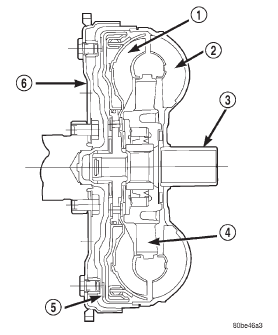
Fig. 9 Torque Converter Assembly
2 - IMPELLER
3 - HUB
4 - STATOR
5 - CONVERTER CLUTCH DISC
6 - DRIVE PLATE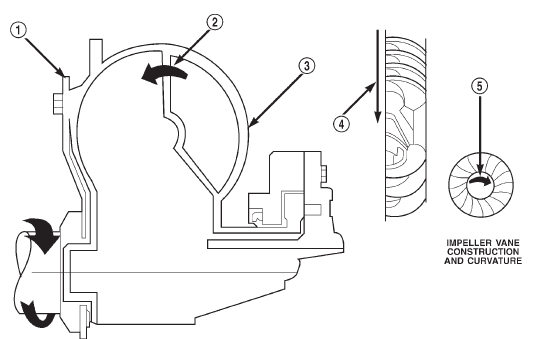
Fig. 10 Impeller
2 - OIL FLOW FROM IMPELLER SECTION INTO TURBINE
SECTION
3 - IMPELLER VANES AND COVER ARE INTEGRAL
4 - ENGINE ROTATION
5 - ENGINE ROTATION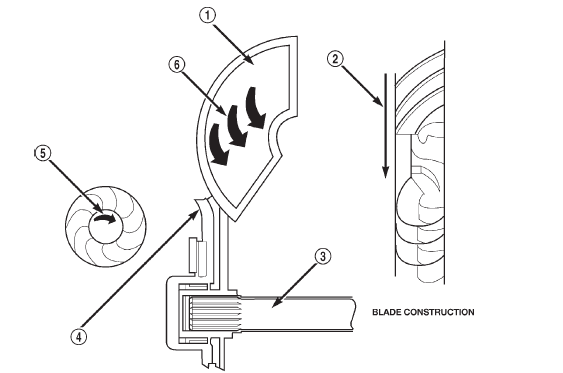
Fig. 11 Turbine
2 - ENGINE ROTATION
3 - INPUT SHAFT
4 - PORTION OF TORQUE CONVERTER COVER
5 - ENGINE ROTATION
6 - OIL FLOW WITHIN TURBINE SECTION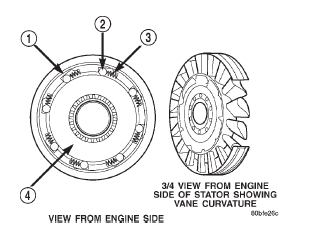
Fig. 12 Stator Components
2 - ROLLER
3 - SPRING
4 - INNER RACE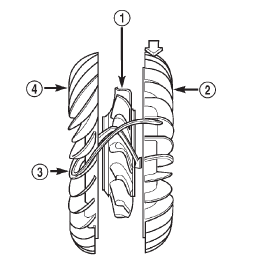
Fig. 13 Stator Location
2 - IMPELLER
3 - FLUID FLOW
4 - TURBINE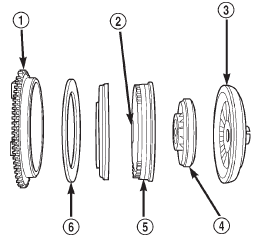
Fig. 14 Torque Converter Clutch (TCC)
2 - THRUST WASHER ASSEMBLY
3 - IMPELLER
4 - STATOR
5 - TURBINE
6 - FRICTION DISC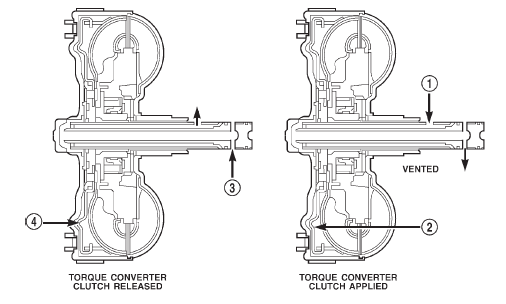
Fig. 15 Torque Converter Fluid Operation
2 - THE PISTON MOVES SLIGHTLY FORWARD
3 - RELEASE PRESSURE
4 - THE PISTON MOVES SLIGHTLY REARWARD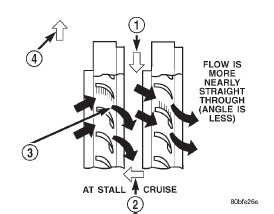
Fig. 16 Stator Operation
2 - FRONT OF ENGINE
3 - INCREASED ANGLE AS OIL STRIKES VANES
4 - DIRECTION STATOR IS LOCKED UP DUE TO OIL PUSHING
AGAINST STATOR VANESOil pump
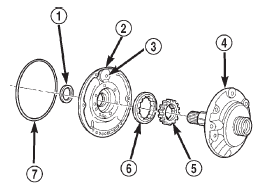
Fig. 17 Oil Pump Assembly
2 - OIL PUMP BODY
3 - VENT
4 - REACTION SHAFT SUPPORT
5 - INNER ROTOR
6 - OUTER ROTOR
7 - "O" RING
Other materials:
Enabling And Disabling The ParkSense Active Park Assist System. Parallel Parking Space Assistance Operation/Display. Perpendicular Parking Space Assistance Operation/Display
Enabling And Disabling The ParkSense Active Park Assist System
The ParkSense Active Park Assist system can be enabled
and disabled with the ParkSense Active Park Assist
switch, located on the switch panel below the Uconnect
display.
ParkSense Active Park Assist Switch
To enable the ParkSens ...


